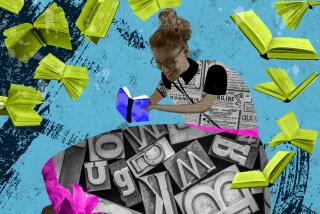In Children’s Books, Classics Offer a Refreshing Rectitude
- Share via
If you’ve been to a children’s bookstore or a children’s section of a general bookstore lately, you’ve surely noticed the explosion in the genre.
As an obvious advocate of reading, I’m glad to see so many new titles and new types of books. But I’m also hoping that parents and children will not forsake the more established traditional literature--the old stories that have been passed from generation to generation.
I think that children can gain benefits from traditional literature that they may not get from contemporary stories. They learn, for example, how humans have sought answers and explanations for nature and natural phenomena throughout human history, even before science was there to help.
They also can begin to understand and appreciate similarities between the plots, characters, and themes of stories from around the world. (There are, for example, about 900 versions of “Cinderella.”)
The best traditional literature fires the imagination of children. The supernatural and exaggerated elements of it provide great inspiration for writing, artwork and storytelling.
The universality of human emotions, concerns, questions, and experiences is also demonstrated in traditional literature. That helps children recognize what it is to be human, and how little human nature changes from time to time and from place to place.
Finally, traditional literature helps reinforce a message that is all too often absent these days in movies, pop music, video games and other books: the importance of being good. Folk tales, myths, fables and legends repeatedly illustrate the value and reward in honorable traits such as loyalty, bravery, honesty, hard work, commitment and respectful treatment of others.
Most traditional literature falls into one of four categories: folk tales, fables, myths and legends.
* Folk tales are narrations in prose form that are generally fictional. They usually take place in a distant time and place, and include supernatural characters such as giants, wizards, fairies and witches. As a result, of course, there are plenty of spells, potions, magic tasks and miracles.
Folk tales generally teach a moral lesson--most commonly that goodness is rewarded and evil is punished--so characters are either clearly good or clearly bad, and in major conflict.
Some folk tales employ humor to portray comical or foolish characters, ridiculous situations, and foolish decisions and actions. Some explain why people or animals have certain traits or behave in certain ways. In fact, they’re actually called pourquoi tales (pourquoi means “why” in French). Such a tale might explain why giraffes have long necks, for example.
*Fables have been a popular form of traditional literature and storytelling for centuries. Many are attributed to Aesop, a Greek slave of the 6th Century B.C., although scholars suspect that there may have been more than one author involved.
Fables generally feature animals that act and talk like people, to dramatize a fictional story with a deeply moral message. They are short and have simple action and few characters.
*Myths are the stories created by cultures everywhere to explain the origin of the world and its creatures, as well as natural occurrences such as lightning, floods and change of seasons.
Myths were accepted as truth, and sometimes even religious doctrine, by their audiences. In many cases, the supernatural beings who starred in myths were worshiped as gods and goddesses.
While there are many rich mythologies to sample, I would suggest that you include at least some of the myths of ancient Rome and Greece in your child’s reading. After all, much of the literature that he or she will read in school and beyond will include important allusions and references to these mythological characters and events.
*Legends, finally, are stories that generally have some historical basis, and therefore contain some kernel of truth. King Arthur and Robin Hood are good examples of legendary figures.
The earliest legends were actually epics--book-length poems--although most surviving legends today exist in prose form. In either case, they generally feature the valiant deeds of saints, martyrs, heroes and heroines from a variety of backgrounds. The emphasis is almost always on bravery, honor, and other noble traits and actions, and good always wins over evil.
There are far too many excellent editions of folk tales, fables, myths, and legends for me to attempt recommending titles. But I do suggest that you look for collections of stories rather than single volumes, since it will provide more variety and use for your child.
Among the Westside bookstores I can recommend for their selection and variety of traditional children’s literature are Midnight Special in Santa Monica, Dutton’s in Brentwood and Children’s Book World in West Los Angeles.
Mary Laine Yarber teaches English at Santa Monica High School.
More to Read
Sign up for our Book Club newsletter
Get the latest news, events and more from the Los Angeles Times Book Club, and help us get L.A. reading and talking.
You may occasionally receive promotional content from the Los Angeles Times.










